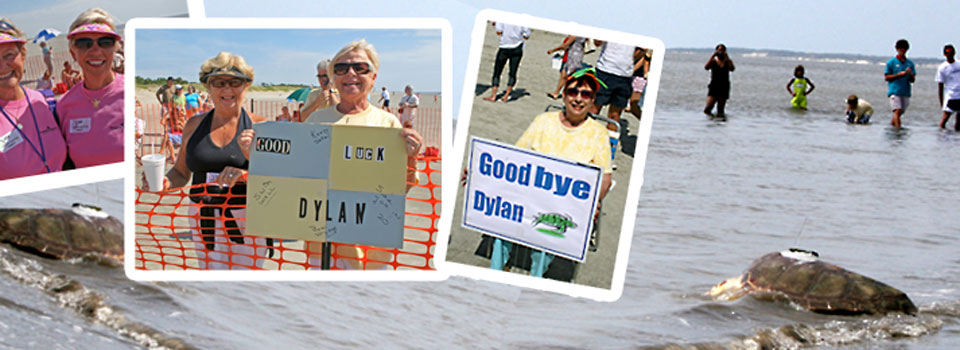Ten years ago on Jekyll Island, two loggerhead turtle hatchlings were trapped in their nest on the beach and unable to get to the water. Georgia Graves saw them, rescued them, named them Bob and Dylan and brought them to the Georgia 4-H center on the island.
Now a whopping 150 pounds, Dylan was released into the Atlantic Ocean June 30 off the island where she was born. Squashing the myth that turtles are slow, she quickly waddled into the water.
A crowd of 300 chanted “Go Dylan! Go!”
Her brother, Bob, was released three years ago.
Dylan spent the first seven years of her captive life at the Jekyll Island 4-H Center, one of six environmental education facilities operated by the University of Georgia College of Agricultural and Environmental Sciences.
“She was definitely the biggest draw in the aquarium room,” said Tom Woolf, animal care coordinator for the 4-H center and UGA’s Tidelands Nature Center. “She liked to splash you with water if you walked by the tank as if to say ‘feed me.’ I cut up a lot of fish for that turtle.”
After helping to educate more than 30,000 4-Hers and Jekyll Island visitors about wildlife conservation, Dylan moved to the Georgia Aquarium in Atlanta in November 2005. While there, another 4.6 million people were able to see her and learn more about conservation.
“She loved to play with ice blocks and rubber balls,” said Jeff Krenner, who cared for Dylan at the aquarium. “And she really liked for her shell to be scratched.”
She returned to the Georgia Sea Turtle Center on Jekyll Island in May 2007. While being prepared for her release, Dylan continued to educate visitors to that center. She learned not to be afraid of blue crabs and to consider them prey, along with horseshoe crabs and whelks.
Woolf says Dylan is a perfect example of the benefits of keeping wild animals in captivity. “All the effort is well worth it when you see how many people were reached through this one animal,” he said. “The more people are aware and emotionally connected to wild animals, the more people will want to protect them and their habitats.”
Although Dylan’s story is a successful one, Woolf warns that wild animals are often harmed by people who think they are helping.
“For example, on some barrier islands a lot of baby gopher tortoises are thrown into the ocean by people who think they are helping,” he said. “These are total land animals. Sometimes by trying to help a wild animal, you may be doing more harm than good.”
He encourages people to contact a state wildlife agency or local nature center for assistance before helping any wild animal.
Despite being back in her native habitat, Dylan’s job as an educator isn’t over. She will still reach students through the tracking device mounted on her shell.
“Next year, my wife’s students at St. Simons Elementary will be watching Dylan and tracking where she goes,” said Mark Dodd, a wildlife biologist with the Georgia Department of Natural Resources. “She’s done a spectacular job teaching marine conservation, and this is exactly why we bring stragglers in.


